The global silver market could face a deficit of 126 million ounces by 2020 and could send silver prices surging
As the market fixates on the price of oil and other real assets, a dramatic scenario is building in the silver market. More than two billion ounces of silver have disappeared from the market over the last ten years and we could be facing an annual shortage of more than 100 million ounces by 2020.
Not only is demand for silver surging and annual supply growth going nowhere but much of our available silver is being buried in public landfills. As a major component in batteries, CDs, circuit boards and other electronics, people are literally throwing their silver in the trash.
That may be something they soon regret as the world runs out of silver and prices skyrocket.
Silver Demand is Surging and Cannot be Stopped
Even as our supply of silver disappears from the market, demand is building every year. Demand for silver is mostly from three important categories; investment, jewelry and industrial uses. These three categories make up 95% of silver demand and they are all growing at a strong rate every year.
Demand for all three major uses of silver have increased over the five years since 2009 but the real story is in the growth in investment and industrial uses. Investors have rushed to silver as central bankers around the world print money to cover spending, destroying the real value of currencies. Demand for silver coins and bars has jumped at an annual pace of 17.5% over the period.
The surge in investor silver demand as a safe haven asset is nothing new. When the U.S. dollar lost more than half its value from 1971 to 1981, the price of silver rose five-fold. Demand of silver coins jumped 63% to a record 65 million ounces in 2008 as the global financial system collapsed. The market meltdown sent silver prices up more than 37% from 2008 through 2010.
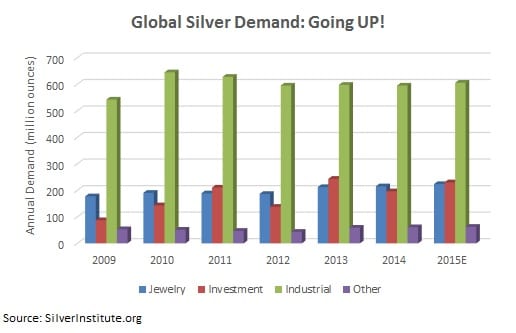
While the annual pace of growth in silver demand for industrial uses has been more modest (1.9%), more than 57% of total demand goes to industrial production. Silver is used in the production process of nearly every industry from electronics to homebuilding and medicine. Demand for silver in photovoltaics for solar energy applications is bounding higher, up 7% in 2014 and up 99% since 2009. Even slower growth in demand amounts to huge additional physical demand, more than 11 million ounces in 2015.
This growing industrial need is an urgent demand. While people may be able to substitute their jewelry demand for silver with another metal and investors may be convinced to sell at higher prices, industrial demand is non-negotiable. The growing need for silver in our industrial progress will not be stopped.
Silver Supply is Shaky and Supply Shocks Abound
In comparison to the rapidly rising demand for silver, especially in investment and industrial uses, the annual supply of silver is much more questionable.
In the past, sales of silver holdings from governments and scrap could fill the gap between higher silver demand and slow growth in mining. The U.S. government alone dumped more than five billion ounces of silver onto the market since World War II to keep prices subdued. The growth in investment demand over the last five years means nobody wants to sell their scrap silver, reducing the annual supply from scrap by 33 million ounces.
The bigger story in the supply picture though is the complete sellout of government holdings. Governments around the world sold 44 million ounces of silver in 2010, supplying more than 4% of the market and keeping the price from rising. Governments have all but sold out of their entire silver holdings and we’ve now lost an important source of supply.
Government silver holdings have fallen 75% to 78 million ounces from over 316 million ounces in 2005. There were no government sales of silver in 2014 and none are expected in 2015 when official numbers are released. Those controlling the remaining government holdings of silver can see the developing deficit in supply and demand as well as anyone. They’re holding on to what little silver stockpile is left for when the silver crisis erupts into higher prices.
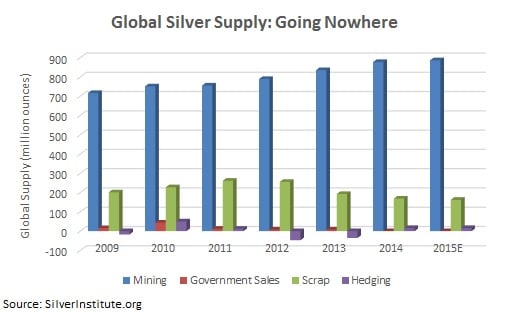
The disappearance of supply from government sales and scrap has put the entire weight of silver supply on mine production…and the outlook for mine production is not good.
As the price of silver and other metals has come down over the past few years, miners have drastically pulled back on their development spending. Near-sighted mining executives have cut hundreds of billions from development plans in order to protect cash flow. This represents the bottom of a cycle that gets repeated every ten years without fail. A mining boom causes production to increase and prices to come down which leads to cuts in development spending. Existing mines are tapped out and fewer new mines are developed, leading to a steep drop in mine production which leads to surging prices.
Not only is the total supply of silver in question but the sources of mining supply are not nearly as stable as you might think. More than 80% of the world’s mining supply of silver comes from just nine countries, seven of which are considered less developed emerging markets.
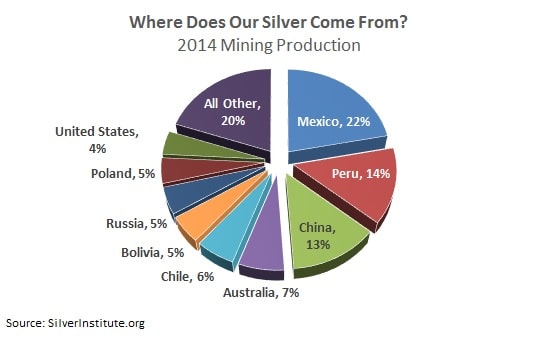
Most of these countries, especially those in Latin America, have been slammed by falling currency values and plunging oil prices over the last year. Besides cutting back on overall development spending, miners are getting out of risky markets like Mexico, Peru and Russia where government resource taxes could be going up to cover budget deficits.
The volatility in mining and employment almost always leads to large scale protests and mine closures as governments fight with mining syndicates over profits. Just the 15 largest silver mines produced 20% of the world’s mining production in 2014, with all but three of the mines in politically risky and unstable countries. Any sudden stoppages in production could seriously affect estimates for silver supply.
Peak Silver and Surging Prices
The silver market is perennially in deficit with demand outstripping supply by millions of ounces. While the annual deficit hasn’t become a full-blown crisis yet, it may not be long before the headlines start inciting panic over shrinking supply.
Silver supply from mining has peaked and the market won’t be able to balance itself with government sales or scrap as it’s done in the past. Investors are already rushing in to buy and hoard their silver in anticipation of higher prices over the next few years.
The silver crisis has already manifested in coin production but is about to get much worse. The U.S. Mint announced in 2010 that it had run out of silver bullion and was forced to suspend production of American Eagle Silver Proof coins.
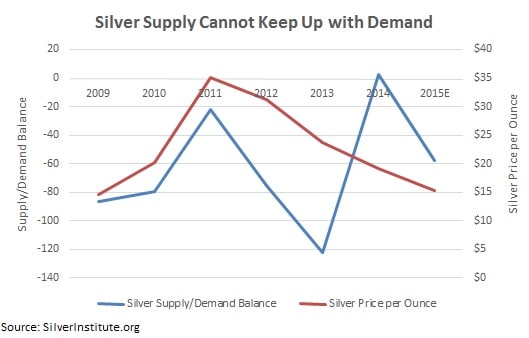
If these trends in silver supply and demand continue, we’ll face a dramatically worsening scenario in just a few years and could run out of silver by 2020. Silver demand is set to increase to 1,466 million ounces by 2020 on its 5-year pace of growth. Even if miners can continue to eke out growth, an unlikely outcome on reduced mine development, the supply of silver is only expected to grow to 1,079 million ounces through 2020.
The above-ground inventory of silver stood at 1,808 million ounces in 2014 but more than 635 million ounces of this was held by exchange traded funds (ETF). Those holdings won’t be available for use as investors will hold onto their silver, guarding it as prices climb higher.
Removing the silver in ETF storage and using available inventory to offset the annual expected deficit between supply and demand, the global market could run out of silver by 2020.
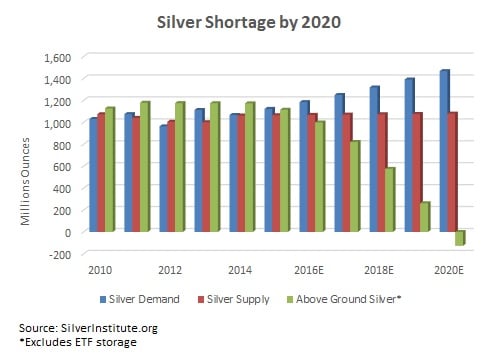
The global silver market could be facing a deficit of 126 million ounces a year by 2020. That deficit will have to be filled somehow. Demand for silver in industrial production is not going to slow down but will look to fill its demand from the only available source besides mining, investors. The growing problem of scarcity will send silver prices surging to convince investors to sell their holdings to industrial users.
The silver shortage will affect nearly every aspect of your life, causing shortages and higher prices in home goods, medicine and industrial products. The only way to protect yourself and even benefit from the coming crisis will be to add silver to your portfolio of safe haven assets now. As the silver crisis develops, holding the metal may evolve from an investment to a necessity for protection against runaway prices and uncertainty.
Most 401k plans restrict your investments to stock funds and bonds, limiting your ability to position for the coming silver crisis. Rolling your 401k plans into an individual retirement account (IRA) allows for greater investment flexibility and puts you in control of your retirement planning. The coming silver shortage means an investor in silver coins and bullion may be one of the best retirement investments you make.








